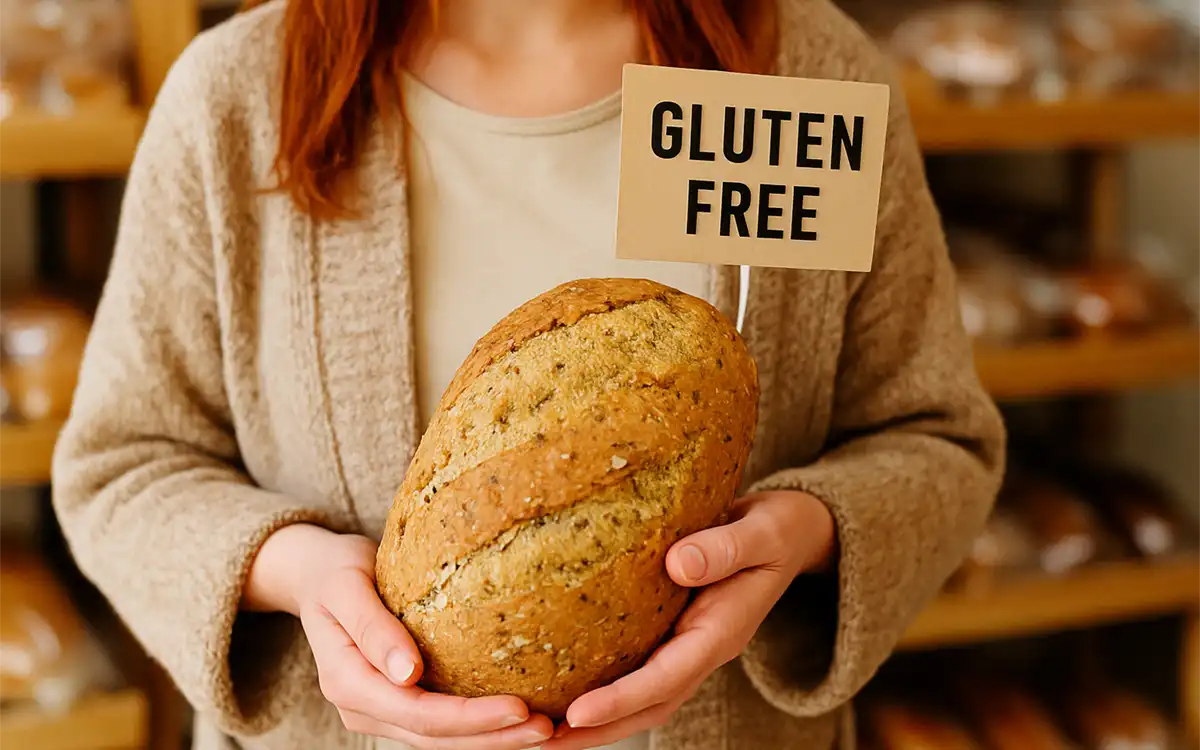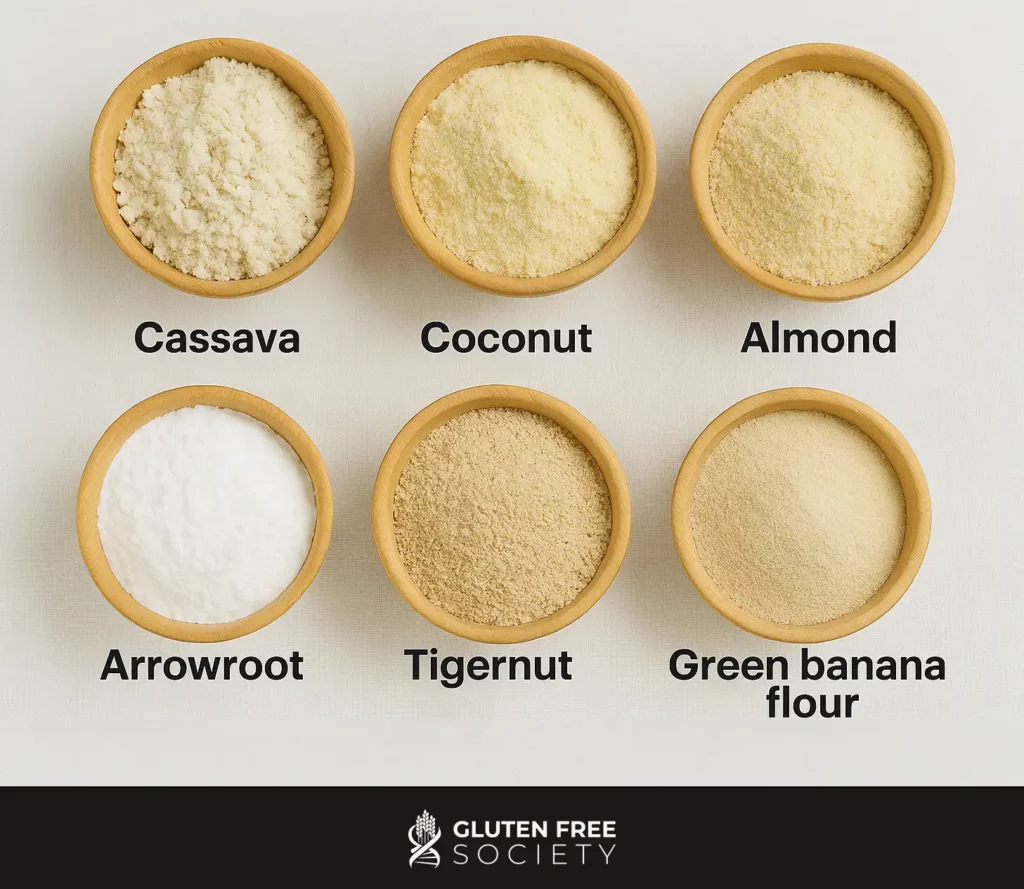new to the gluten free journey?
new to the gluten free journey?

Has love for bread been curtailed by gluten sensitivities? Well we’ve got good news for you. There are so many options for gluten free bread, ready to satisfy your bread cravings. But not all gluten free bread is created equal. In this article, we will explore various gluten free bread options, examining their ingredients, nutritional value, and suitability for your dietary needs. Let’s dive in.
Contents
ToggleGluten is the protein in grains that lends elasticity to bread and other baked goods. Gluten is often associated with wheat, rye, and barley. However, we know that gluten protein can be found in ALL grains. Common foods containing gluten include pasta, bread, baked goods, and beer, as well as many sauces, condiments, and marinades.
Celiac disease is an autoimmune condition that is triggered by the ingestion of gluten, a protein found in grains like wheat, barley, and rye. Gluten proteins trigger inflammation in the intestinal tract and other parts of the body. This systemic inflammation can then contribute to the development of autoimmune disease and a host of other health issues.
Gluten sensitivity is an inflammatory reaction that develops when those with genetic susceptibility consume or ingest gluten. The inflammatory reaction can manifest in a myriad of different ways. These individuals do not develop celiac disease – hence the term Non Celiac Gluten Sensitivity (NCGS).
If you have celiac disease or gluten sensitivity, you likely have been avoiding bread since you were diagnosed or started suspecting that gluten was the culprit of your symptoms. Or you might have tried some gluten free bread alternatives and been disappointed at the taste or texture.
Oftentimes, gluten free bread is hard, dry, crumbly, and flavorless. Many people find that they have to toast it in order to be remotely edible. These breads are often made of so-called gluten free grains, like rice flour, but they tend to be difficult to digest, and unpleasant to eat. In addition, many of these products are GMO, contain unhealthy chemical additives, as well as sugar and gum based fillers.
The good news is that there are several grain free flours that can be made into delicious bread that is tolerated well by those with celiac disease and gluten sensitivity. We will discuss these types of flours and breads in the sections that follow.
Sourdough bread is made from gluten containing grains, but since those grains are fermented over time, sourdough is often touted as being safe for those with celiac disease and non celiac gluten sensitivity. While it is true that sourdough bread contains less gluten than regular bread, it still contains enough gluten to be over the 20 ppm threshold to be considered gluten free. Regular bread contains approximately 124,000 ppm of gluten per slice. Sourdough bread can vary significantly based on fermenting time and method, but has been tested to contain in excess of 200 ppm of gluten per slice. While greatly reduced, sourdough can still contain gluten amounts that are far in excess of safe gluten free levels.
There’s been a rise in popularity of different types of grains, including sprouted and ancient grains. These breads are made by sprouting grains before using them in bread. The grain is used when it is sprouted during the germination process, which breaks down some of the starch and makes the percentage of nutrient content higher. It also breaks down phytate, a form of phytic acid that normally decreases absorption of vitamins and minerals in the body. However, while sprouted grains have more available nutrients than mature grains and may be slightly easier to digest for some people, they are still grains, and they still contain gluten.
Ancient grains, as the name suggests, have actually been around for a long time, even though they might seem like a relatively new item that is being marketed in foods. These grains include things like spelt, millet, kamut, and farro.
The reason for the spotlight on these types of grains is that many claim that they are more nutritious than modern grains. Most modern grains are not sprouted, and have been adulterated in one way or another – highly refined, genetically modified, or sprayed heavily with pesticides, so it’s easy to imagine how sprouted and ancient grains might be a better choice. However, they are still grains that contain gluten and therefore are not safe to eat on a gluten free diet for those with celiac disease or NCGS.
Whether purchased or homemade, the best gluten free bread is made from a combination of gluten free flours. We discuss these flours below and then share some breads that can be purchased or made using these flours.
Cassava and tapioca flour
Cassava flour and tapioca starch are both made from the cassava root. While they are made from the same plant, and both useful in gluten free bread, they are different products with different properties.
Tapioca is a starch extracted from the cassava root. The wet pulp is extracted and then squeezed to retrieve a starchy liquid. Once all the water evaporates from the starchy liquid, the tapioca flour remains.
Cassava flour is the whole root, simply peeled, dried and ground. This means it has more dietary fiber than tapioca flour and behaves more like a flour than a sticky starch. Cassava has a very slightly earthy and nutty flavor and is much lighter than all-purpose flour. Cassava flour is very easily digested by those with gut sensitivities.
While cassava flour is higher in carbohydrates than any other gluten-free flour substitutes, it is lower in sodium, fat, sugar, and overall calories than almond or coconut flour. It is also a good source of vitamin C.
Cassava flour can be used to bake brownies, cookies, pita bread, tortillas, pizza crust, and many other baked goods. Using cassava flour can give recipes a boost in fiber as well. It can also be used as a thickener to make gravies and roux, or used as a binder for hamburgers and meatloaf. However, a little trial and error will be needed to master your recipes.
Coconut flour
Coconut flour is made from the meat of fresh coconuts. It imparts a slight coconut flavor into any recipe in which it is used. However, coconut flour is typically combined with other flours in recipes, so its coconut flavor is muted.
Due to its high fiber content, coconut flour will soak up moisture in your recipes. For baked goods, it is best to add an extra egg, chia seed or flax seed slurry, unsweetened applesauce or water to keep your recipe moist.
Coconut flour is a great source of fiber and is low in carbohydrates, which makes it very friendly for diabetics. Coconut flour can also be used as a thickener for gravies, soups, stews, and roux.
Almond flour
Almond flour is made from finely ground almonds. If you tolerate almonds, and you like the nutty flavor, it can be a great gluten-free flour substitute for regular all-purpose flour. It is high in protein and healthy fats and low in carbohydrates. It is also a good source of fiber and vitamin E.
For cakes, cookies, and muffins, a 1:1 substitution for all-purpose flour is appropriate for most recipes. Adding slightly more of your leavening agent is a good tip as well. Almond flour is a heavier flour, so leaving your baked product in the pan a little longer after removing it from the oven is best. As a side note, almond flour is high in oxalates. Many with gluten issues also have issues with high oxalate foods.
Arrowroot flour
Arrowroot flour is another great gluten-free flour substitute. It is extracted from the pulp of the arrowroot plant, Maranta arundinacea. Arrowroot flour is high in protein and several nutrients. It is easily digested and can be used in recipes for those who have a sensitive gut.
Arrowroot is known to also help regulate blood sugar and cholesterol levels. Like tapioca flour, arrowroot has a neutral taste. It can also be substituted for cornstarch as a thickening agent in soups, gravies, sauces, stew, puddings and custards. Arrowroot starch can be used in baked goods, substituting ¼ of the flour in the recipe. It can also be used to add a crispy texture to “oven-fried” foods.
Tigernut flour
Tigernut flour is made from ground tiger nuts. However, despite the name, tiger nuts aren’t actually nuts, it is a root plant. This means it is tolerated well by those with sensitive digestion, including those on an autoimmune protocol (AIP) diet.
Tigernut flour is high in fiber and protein and helps maintain blood glucose levels. It is a resistant starch that can keep the gut healthy by feeding good bacteria. Taste-wise, it is nutty and sweet. It can be used to bake cookies, brownies, pancakes, tarts, doughs, and breads. Baking requires a 1:1 substitution ratio for wheat flours. Again, trial and error are needed to perfect your favorite recipes.
Green banana flour
Green banana flour is one of the newest gluten free flour substitutes to market. It is made from unripe green bananas and processed before the natural fruit sugars are formed.
Green banana flour is loaded with nutrients, especially potassium, and is a highly resistant starch. This makes it a good choice for a healthy gut. It has an earthy flavor and can be used in smoothies, muffins, cupcakes, cookies, breads, cakes, waffles, and as a thickener for sauces. For baking, use 1/3 cup less green banana flour than wheat flour to substitute in your recipes. Experimentation is the key to having success in your recipes.

The best gluten free bread is made from a combination of the gluten free flours discussed above. Gluten free bread can be either homemade or purchased. However, if purchased, it is important to ensure that there is no risk of cross contamination.
Our top choice for purchased gluten free bread is our own Warrior Bread Mix. It is made from whole food ingredients including almond flour, organic coconut flour, organic psyllium husk, dehydrated sweet potato, baking soda, and sea salt. Warrior Bread is quick and easy to make, and can be made into a variety of different forms.
Warrior Bread Mix is extremely versatile, and can be used to make a number of classics, including:

There are other gluten free breads for sale made from these flours. However, they tend to be expensive and sold frozen, making them difficult to store or to eat in any way other than toast. A few examples include Base Culture, Julian Bakery, and Unbun.
Another option is to make homemade gluten free bread. This requires some extra effort, but the result is a delicious fresh tasting bread. Here are two good options:
While most breads on the market contain gluten and are not safe for people with celiac disease or gluten sensitivity, there are plenty of great gluten free flours available to make delicious gluten free breads.
Breads made from gluten-free flours such as almond, tapioca, coconut, and cassava are naturally free from gluten.
Not all gluten-free breads are created equal. Some may contain high amounts of sugar, fats, or refined starches to improve taste and texture. It’s important to check the nutritional labels and opt for breads without artificial flavors, food gums, preservatives, additives, and GMO ingredients.
Traditional sourdough bread is made from wheat or other gluten-containing grains. While the fermentation process reduces the gluten content, it does not eliminate it entirely. Therefore, sourdough bread is not considered safe for those avoiding gluten.
Look for breads labeled with a certified gluten-free symbol or statement on the packaging. Additionally, check the ingredient list to ensure it doesn’t contain wheat, barley, rye, oats, corn, rice, or other gluten-containing grains.
Yes. Anyone can consume gluten free bread.
When selecting gluten-free bread, consider factors like taste, texture, nutritional content, and ingredient quality. Opt for breads with whole food based ingredients and minimal added sugars or artificial additives.
Yes, many gluten-free breads are designed to mimic traditional sandwich bread in texture and taste. Brands like Gluten Free Society’s Warrior Bread offer gluten-free loaves that are soft and suitable for making sandwiches.
Stay up-to-date with the latest articles, tips, recipes and more.

*These statements have not been evaluated by the Food and Drug Administration. This product is not intended to diagnose, treat, cure or prevent any disease.
If you are pregnant, nursing, taking medication, or have a medical condition, consult your physician before using this product.
The entire contents of this website are based upon the opinions of Peter Osborne, unless otherwise noted. Individual articles are based upon the opinions of the respective author, who retains copyright as marked. The information on this website is not intended to replace a one-on-one relationship with a qualified health care professional and is not intended as medical advice. It is intended as a sharing of knowledge and information from the research and experience of Peter Osborne and his community. Peter Osborne encourages you to make your own health care decisions based upon your research and in partnership with a qualified health care professional.
7 Responses
I do use some of the flours you recommend and had good luck most often. I also use spelt flour, are there other flours you would mix with spelt for bread. The recipe calls for quite a bit of yeast? Thank you for such helpful information.
I have yeast issues as well. Didn’t you say no grain period$
Does this flower contain carbohydrates for diabetics?
it says 5 carbs per 2 tbsp dry mix so not too bad
I love the Warrior Bread. Unfortunately, I get kidney stones, so need to stay low oxalates, and thus can’t eat the Warrior Bread on a regular basis. I plan to experiment using it as a blend of a third or half of the flour ingredients needed for bread and use some of the other GF flours listed above.
How do I discontinue the monthly shipment of Warrior Bread? Believe I had it set up for 2 packages every 4 weeks/ 1 month. Please advise.
Thank you
Email out customer support staff – glutenology@gmail.com
All the best!